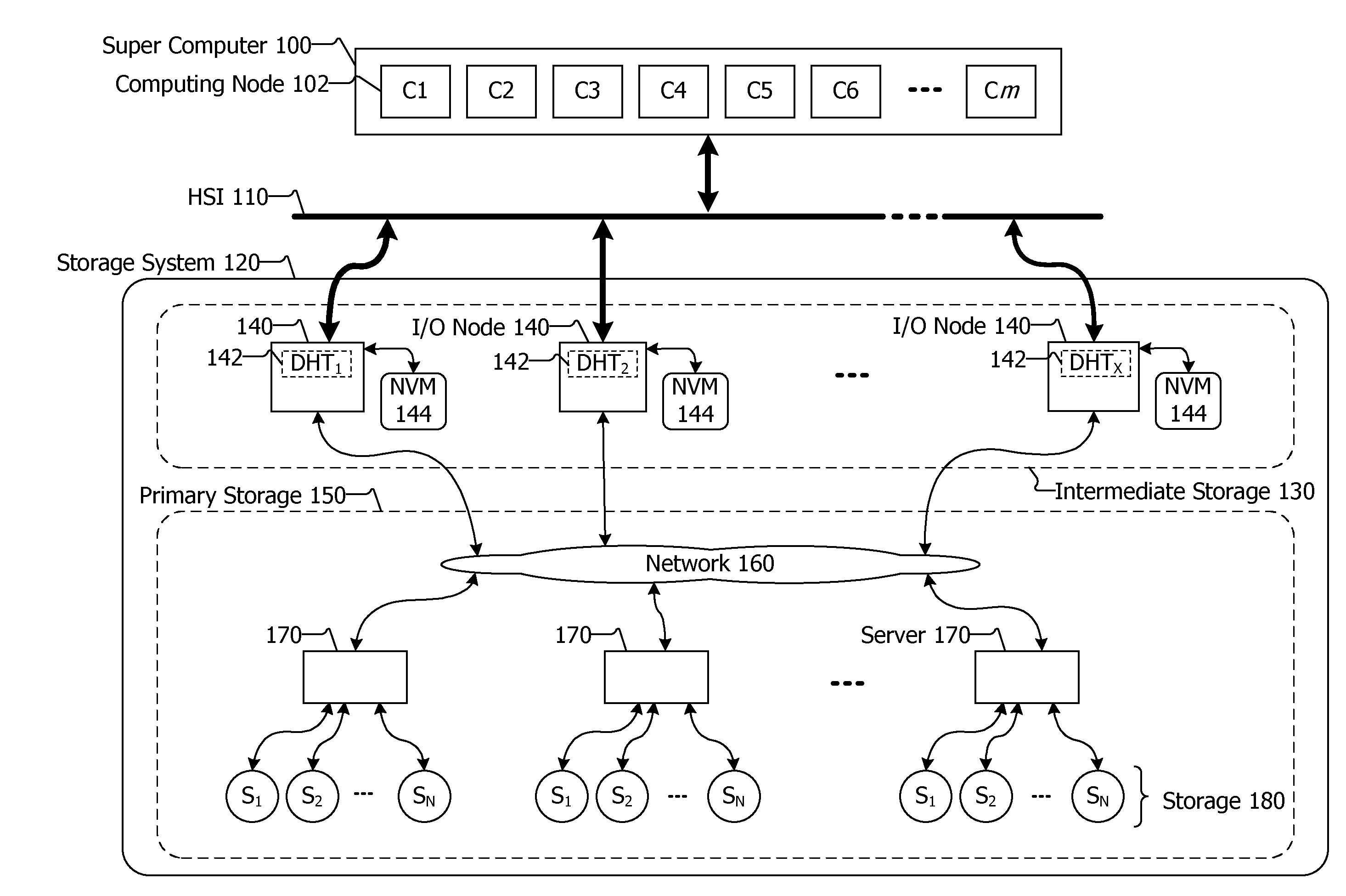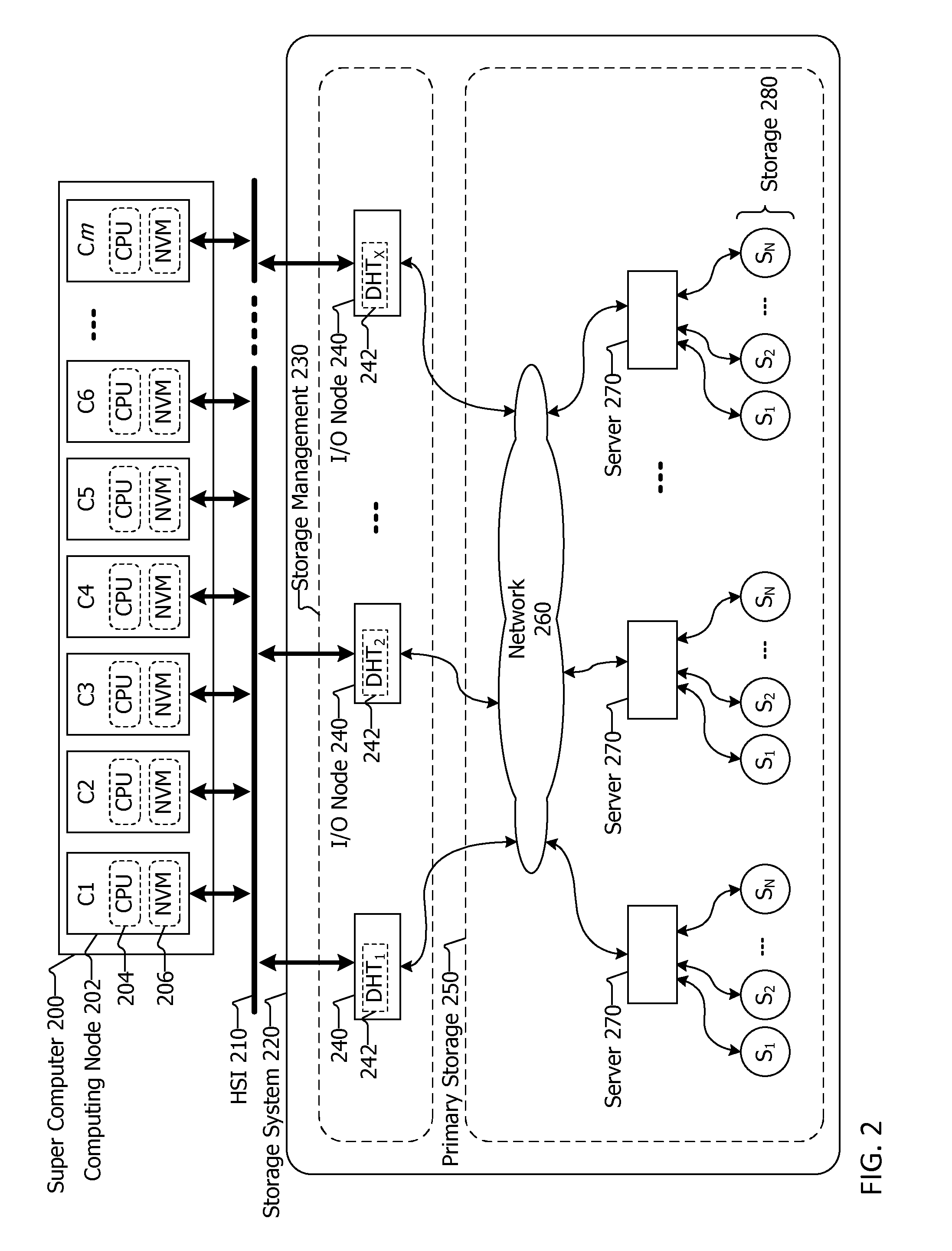Data storage architecture and system for high performance computing
a data storage and high-performance computing technology, applied in the data field, can solve problems such as system delays, system risk of corrupting files, zest and plfs have significant deficiencies,
- Summary
- Abstract
- Description
- Claims
- Application Information
AI Technical Summary
Benefits of technology
Problems solved by technology
Method used
Image
Examples
first embodiment
[0021]FIG. 1 is a block diagram of a data storage system 120 coupled with a super computer 100. The super computer 100 may be a compute cluster that includes a plurality of computing nodes 102. Similarly, the compute cluster may be a super computer. Each computing node has at least one core and may have multiple cores, such as 2, 4, 8, 32, etc. The computing nodes may be in one or more racks, shelves or cabinets, or combinations thereof. The super computer 100 is coupled via a High Speed Interconnect (HSI) 110 to the data storage system 120. The HSI 110 may conform to the INFINIBAND, CASCADE, GEMINI architecture or standard and their progeny, may be an optical fiber technology, may be proprietary, and the like. The data storage system 120 includes intermediate storage 130 and primary storage 150. The intermediate storage 130 includes a plurality of servers referred to as I / O node 140, each I / O node having a portion of a Distributed Hash Table (DHT) 142 included therein, and having N...
second embodiment
[0040]FIG. 2 is a block diagram of a data storage system coupled with a super computing system. In this embodiment, super computer 200 includes multiple computing nodes 202. Similarly, a group of computing nodes may form a compute cluster and the compute cluster may be a super computer. Each computing node includes a CPU 204 and its own NVM 206. The CPU may be single core have multiple cores. An advantage of this configuration is that the NVM is included in the computing nodes 202 to increase speed of access to the NVM 206 by the CPU 206 in the same computing node 202. In this configuration, the use of NVM, regardless of its location, is unbounded such that data from any of the CPUs may be stored to the NVM of another computing node. When data is to be written by a CPU in one computing node to the NVM of another computing node, the appropriate I / O node must be updated or notified about the computing node writing to the NVM of another computing node. This is because the I / O nodes 240...
third embodiment
[0042]FIG. 3 is a block diagram of a data storage system coupled with a super computing system. In this embodiment, the I / O nodes 310 are included in the super computer 300 or within or closely coupled with a compute cluster of computing nodes. This contrasts the other embodiments shown in FIGS. 1 and 2 in which the I / O nodes are included in a storage system coupled with the super computer. Further, the NVM 306 is included in the super computer 300 and is accessible to both computing nodes 302 and the I / O nodes 310 via a local interconnect 304. The local interconnect 304 may conform to the serial attached storage (SAS) standard, the peripheral component interconnect express or PCI Express standard, may implement a DRAM-like protocol or other data communication standard or technology. This configuration allows computing nodes 302 to access any available NVM 306. The use of the DHT 312 in the I / O nodes 310 allows for quick access to data items stored in the NVM 306 even as the computi...
PUM
 Login to View More
Login to View More Abstract
Description
Claims
Application Information
 Login to View More
Login to View More - R&D
- Intellectual Property
- Life Sciences
- Materials
- Tech Scout
- Unparalleled Data Quality
- Higher Quality Content
- 60% Fewer Hallucinations
Browse by: Latest US Patents, China's latest patents, Technical Efficacy Thesaurus, Application Domain, Technology Topic, Popular Technical Reports.
© 2025 PatSnap. All rights reserved.Legal|Privacy policy|Modern Slavery Act Transparency Statement|Sitemap|About US| Contact US: help@patsnap.com



